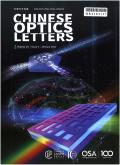用于WDM系统的直接调制25gbaud /s可调串联DFB激光阵列
IF 2.8
2区 物理与天体物理
Q2 OPTICS
引用次数: 0
摘要
在本文中,我们提出了一种基于多波长分布反馈(DFB)激光阵列的直接调制可调谐激光器,并进行了实验验证。这些激光器是串联放置的,以避免使用光合并器和额外的功率损失。采用三段式设计,减少了其他激光器的干扰,提高了电光响应带宽。此外,利用重构等效啁啾技术简化了光栅的制作,实现了光栅相位的精确控制。我们实现了12个100ghz间隔的通道,具有50db以上的高侧模抑制比。所有通道的输出功率均在14mw以上。在100毫安的偏置电流下,所有四种激光器的3db电光带宽都在20千兆赫以上。在所有12个通道上,在长达10公里的标准单模光纤上实现了25 Gb/s的数据传输,并通过四电平脉冲调幅获得了每波长50 Gb/s的数据传输。所提出的直接调制可调谐串联DFB激光阵列显示了用于波分复用(WDM)系统(如下一代前传网络和无源光网络)的紧凑低成本光源的潜力。本文章由计算机程序翻译,如有差异,请以英文原文为准。
Directly modulated 25 Gbaud/s tunable in-series DFB laser array for WDM systems
In this Letter, we proposed and experimentally demonstrated a directly modulated tunable laser based on the multi-wave-length distributed feedback (DFB) laser array. The lasers are placed in series to avoid the usage of an optical combiner and additional power loss. A three-section design is utilized to reduce the interference from other lasers and improve the electro-optic response bandwidth. Besides, the reconstruction-equivalent-chirp technique is used to simplify the grating fabrication and precisely control the grating phase. We realized 12 channels with 100 GHz spacing with high side mode suppression ratios of above 50 dB. The output power of all the channels is above 14 mW. The 3 dB electro-optic bandwidth is above 20 GHz at a bias current of 100 mA for all four lasers. A 25 Gb/s data transmission over a standard single-mode fiber of up to 10 km is demonstrated for all 12 channels, and 50 Gb/s data per wavelength is obtained through the four-level pulse amplitude modulation. The proposed directly modulated tunable in-series DFB laser array shows the potential for a compact and low-cost light source for wavelength division multiplexing (WDM) systems, such as next-generation front-haul networks and passive optical networks.
求助全文
通过发布文献求助,成功后即可免费获取论文全文。
去求助
来源期刊

Chinese Optics Letters
物理-光学
CiteScore
5.60
自引率
20.00%
发文量
180
审稿时长
2.3 months
期刊介绍:
Chinese Optics Letters (COL) is an international journal aimed at the rapid dissemination of latest, important discoveries and inventions in all branches of optical science and technology. It is considered to be one of the most important journals in optics in China. It is collected by The Optical Society (OSA) Publishing Digital Library and also indexed by Science Citation Index (SCI), Engineering Index (EI), etc.
COL is distinguished by its short review period (~30 days) and publication period (~100 days).
With its debut in January 2003, COL is published monthly by Chinese Laser Press, and distributed by OSA outside of Chinese Mainland.
 求助内容:
求助内容: 应助结果提醒方式:
应助结果提醒方式:


